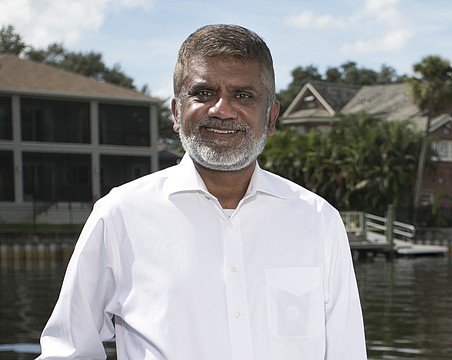Lee
Quaint or practical?
After the controversy surrounding drawbridges in Clearwater and Sarasota, the pelicans have come home to roost in Lee County, as the county Department of Transportation and the county commissioners wrestle with the construction of a new bridge to Sanibel and Captiva islands - two of the state's most popular tourist spots.
A questionnaire has been mailed to island residents and holders of bridge toll transponders. Respondents are given a choice of three alternatives as a replacement for the existing 26-foot high span of the current drawbridge: construct a similar bridge span at the same height for $18.4 million; construct a higher drawbridge span at 50 feet for $22.7 million; or construct a fixed span over the channel at 70 feet for $15.5 million. All three estimates are in year 2000 dollars.
The question of how to replace the deteriorating drawbridge has raged for months. Sanibel and Captiva traditionalists, some of whom successfully stopped the construction of a McDonald's, argue for a simple 26-foot high replacement. The drawbridge, they contend, is emblematic of the tempo of Sanibel, an island that attracts tourists in part because of its laid-back ambiance. They say that being able to raise the bridge whenever a crime suspect tries to flee the island is a deterrent to crime.
That's a sentiment that island business owners can relate to but many favor a bridge that doesn't have to be opened for every passing sailboat. "It's not so much how long it takes to get on the islands," says Steve Greenstein, executive director of the Sanibel & Captiva islands Chamber of Commerce, "it's how long it takes to get off."
Greenstein says the chamber hasn't taken a position on which alternative it favors. "Our mission has been simply to keep our business members informed." Greenstein believes that traffic backed up on Periwinkle Way, the main business artery on Sanibel, often for a mile or more, is the main quality of life issue that business owners are concerned with. "From what I hear, there is no single plan that will satisfy everyone, business people or residents. The thing most business people agree on is that bumper-to-bumper traffic waiting to get off the island is not the most positive memory to leave the islands with."
Peter Adania, general manager at the Sundial Beach Resort, a property owned and operated by the islands' largest accommodations company, believes that the 50-foot high drawbridge might be an acceptable compromise. According to DOT, it would allow 75% of the boat traffic that now requires a bridge opening to pass under the closed span. Adania says he doesn't hear many complaints from guests about the bridge or the traffic. Inconveniencing staff, however, is another matter. "Seventy-five percent of our employees commute in their individual cars. Leaving the islands between 3 and 5 p.m. is a problem."
Perhaps the most colorful response to the questionnaire may be a write-in vote from Sam Bailey, owner of Bailey's store, an island fixture since before there was a bridge. "Everyone knows where I stand on the bridge," Bailey said at a recent chamber board of directors meeting. "I wouldn't mind if they tore the darned thing down."
SARASOTA
One satisfied customer
It's no secret many real estate developers harbor disdain for what they consider Sarasota city's restrictive land use codes - especially the so-called "Duany Plan," the city's 2010 master plan. But don't count Fort Lauderdale developer Richard Zipes among the naysayers - at least not yet. Zipes is building an 18-story luxury condominium tower on 2.88 acres of land at U.S. 41 and Gulf Stream Avenue.
Not one to mince words, Zipes expresses admiration in his dealings with the Sarasota Planning and Redevelopment Department and the city's Planning Board. "We couldn't be more pleased," he says. "Staff is hired for a reason. They have a job to do. It's very nice when the (elected) commissioners understand and support - and that's the major word here - the staff's findings. That's not the case in many other communities."
At age 64, Zipes says he has fought many battles during his 40-year career as a commercial real estate developer. "Developers take huge risks," he says. "I already have practically a $30 million investment. It's close to a record price for Florida land. So we're at the mercy of the bureaucracy, and I don't mean that in a bad way. That's just the way life is. But in a lot of instances when you have to go for approvals, you can get hammered. I have always tried to play by rules. I'm not suggesting I won't try to bend them, because I will."
Zipes says the city's 180-foot height limitation is too restrictive. But early on in his planning he decided that battle wasn't worth the fight. "That corner I purchased deserves a far greater building height than 180 feet," he says. "It deserves a 30-story building."
Zipes' decision to acquiesce on the matter may be a good thing for Sarasota policymakers, considering he prevailed in a long battle with Fort Lauderdale to erect the 42-story Las Olas River house.
It appears Zipes is about to jump the final hurdle in Sarasota on his way to starting work on the Metropolitan condo building. The Sarasota City Commission approved Zipes' application on first reading at a Sept. 2 public hearing. A second and final reading is scheduled for Sept. 15.
Once he clears that hurdle Zipes plans to pop the cork. "When we (celebrate), we won't do it at Denny's," he says.
So will he be "putting on the Ritz" (as in the neighboring Tower Residences at the Ritz)? "The Ritz will be a figment of our imagination when everything is finished," he says of the Metropolitan.
Environmentalists take aim at golf courses
"I specifically heard, out of (environmentalist/anti-growth attorney) Dan Lobeck's mouth, that he and (Sarasota County Commissioner) Jon Thaxton have worked very hard to make sure no more golf courses are built in this community," says one golf course representative. "They are using golf courses as a vehicle to stop all development in this county."
Golf course owners, managers and developers are furious. They say they are being trampled and used by an anti-growth county commission and anti-growth crowd. On Sept. 10, the county commissioners will hold a public hearing on a proposed ordinance relating to land development and "design standards" for new golf courses.
Groups like the Suncoast Golf Course Association object to the new ordinance, saying it is premised on unsubstantiated assumptions. The purpose of the ordinance is to ensure that golf courses "protect and conserve natural resources and the environment" But as one source says, "they have not proven that golf courses don't already protect and converse the natural environment. We have millions of dollars of research proving that golf courses are actually very good for the environment, including one report by the Sarasota County Extension Service. Golf course grasses and systems actually filter the water - water coming off of golf courses meets standards that pristine, untouched waters can't meet. But the county basically ignored all of that."
All new golf courses must be certified by the "Audubon International Signature Program" or a similar program. Don't get confused by this; this has nothing to do with the Audubon Society, the environmental and natural habitat protection group. The Audubon Society sued Audubon International over the confusion, but lost. AI is affiliated with the U.S. Golf Association, and it purports to certify the environmental-friendly level of golf courses. Until the proposed Sarasota ordinance, it's been a voluntary program; the Sarasota ordinance would be the first to legally mandate the program.
And it's not cheap. AI registration fees will cost a course a minimum of $9,500, with an annual membership fee of $500. Then, for a golf course to get certified, it has to pay AI to do site visits and assessments and studies and audits estimated to cost a minimum of $35,000, but in reality, it will likely cost two or three times that amount. One local golf course that has been trying to get certified under the signature series for more than four years - they have a six-inch thick notebook of documents produced, and have spent more than $35,000 in man-hours and more than $15,000 per year in water tests, and they still have not been certified.
The county's economic impact study of the golf course ordinance states: "[I]t needs to be mentioned that several provisions in the new golf course ordinance may have an economic impact on the part of golf course developers and/or owners. These include costs associated with Audubon International (AI) Certification, the development of a Resource Management Plan, and Water Quality Monitoring. It is not anticipated that these costs will prevent any golf course from being developed, but rather, are costs deemed necessary to ensure that golf courses are compatible with the existing environment."
And Sarasota is only the beginning. The Suncoast Golf Course Association says the following Florida counties are also targeted for golf course restrictions: Polk, Lake, Hillsborough, Lee, Marion and Sumter.
$8 million for air
When that special warranty deed was filed in the Sarasota County Clerk's office on Aug. 19, recording the $8 million sale of property near the Quay from Basin Developments Partnership Ltd. to Irish American Services Ltd., Coffee Talk had to do a little snooping. Turns out, it's for air - air rights, that is. As expected, Basin Developments (owners of the Hyatt - Charles Githler and the Kane brothers) sold the air rights above the Hyatt parking lot to Patrick Kelly, the Irish buyer of the Quay, and his investment group. Kelly and his group, primarily hotel developers in the U.K., are expected to build above that parking lot, preserving parking in the end result for Hyatt use.
Tampa Bay
Give back a tax cut?
A big local supporter of President George W. Bush would favor selective repeal of tax cuts, should the American economy not respond.
That's if you believe U.S. Rep. Jim Davis, D-Tampa. But who's going to doubt a politician?
Davis made his startling claim at an Aug. 28 speech in Pinellas County, which he began representing along with Hillsborough County in Congress after reapportionment following the 2000 Census.
The congressman recalled a 2001 Bush rally in Tampa. The president predicted his first round of $1.35 billion in tax cuts, which he was about to sign into law at the time, would stimulate the economy and reverse the job losses that were then starting and have since accelerated to haunt his administration.
Davis, a lonely Democrat at the Legends Field rally, says he struck up a conversation with a gentleman he identified only as a prominent Republican fundraiser from Pinellas. Davis says he asked the chap what should happen if tax cuts don't work.
This Republican fundraiser replied that tax cuts that don't stimulate the economy should be repealed, according to Davis.
With more jobs being created in Bombay than Brandon lately, Davis, who used to serve on the House Budget Committee, suggested the time had come to heed the alleged advice of this unnamed Republican.
So who was this moneyed man of mystery?
Davis didn't give it away until the end. After telling his tale, Davis commented that he would like to ask what the man thinks now. But the man is overseas, according to Davis.
Upon hearing that, several people in the Suncoast Tiger Bay Club audience at the Feather Sound Country Club in Clearwater were heard to mutter the words: "Mel Sembler."
The St. Petersburg real estate developer didn't confess any loss of faith in tax cuts when he spoke to the club in May. Sembler wasn't able to attend the Davis speech to defend himself.
Bush did not overlook Sembler's work as national GOP finance chair during his 2000 election campaign. The president posted Sembler to Rome, where he is U.S. ambassador to Italy.
Republic up - and out?
The stock of Republic Bancshares Inc., parent of St. Petersburg's Republic Bank, hit a 52-week high of $29.08 on Aug. 22. It had been trading below $25 as recently as June.
The generally upward tick has some in Florida banking circles wondering if a suitor is doing more than talking about buying the recovering Republic.
Once a troubled bank, Republic's loan portfolio grew at an annualized 14% for the first half of 2003 at the same time non-performing loans were cut by 44%, the parent company reported. Net income for the second quarter was up $200,000, compared to the same period in 2002.
Two of the seven brokerages following the banking company are recommending clients buy. But the other five have a hold on the stock. One member of that quintet, Birmingham, Ala.-based Sterne, Agee & Leach Inc., started coverage two days before the Aug. 22 peak with a $30 price target. SunTrust Robinson Humphrey Capital Markets in Atlanta has attributed the recent price jump almost entirely to acquisition speculation.
William R. Hough and William J. Morrison, who sit on the Republic Bancshares board, have exercised options to purchase a combined 300,000-plus shares at $18 during the past six weeks, according to regulatory filings.





